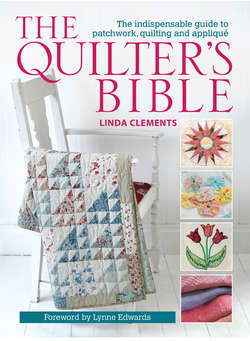Читать книгу The Quilter's Bible - Linda - Страница 64
На сайте Литреса книга снята с продажи.
ОглавлениеBlock Types
The way that blocks are classified depends on the books you read and how deep you want to delve into the subject. Blocks range from simple one-patch designs to complex multi-patch arrangements using a mixture of shapes. The idea of a quilt made up of the same one-patch units or blocks may seem limited but the exciting thing about patchwork is that a single shape repeated over and over but in different colours and fabric patterns can create a vibrant design. As experience grows so too does the thrill of combining different types of block, creating patterns within patterns. Of course, blocks don’t have to be regular and they may also be made up of appliqué motifs rather than be pieced. The following general categories are often used to describe block types, with diagram examples below. Subsequent sections in the book show how to create such blocks.
One-Patch Blocks
These can be made up of various shapes, including squares, rectangles, triangles, diamonds and hexagons, and when combined in certain patterns are given names. These blocks lend themselves well to interlocking, mosaic patterns called tessellations, where combinations of positive and negative space or light and dark tones create fascinating visual illusions.
Four-Patch Blocks
These are easy to sew and so versatile. A four-patch block is made up of four units, but these can be subdivided to create many more patterns. A combination block of four different blocks might also be described as a four-patch block if it is used repetitively in a quilt layout.
Five-Patch Blocks
These are constructed on a five x five grid, so each block would contain a total of twenty-five units. Subdivisions of the elements of the grid can create many more variations. These units do not have to be the same size and the central one can be narrower or wider than the flanking ones.
Seven-Patch Blocks
These blocks are constructed on a seven x seven grid, so each block would contain forty-nine units and so can build into very complex patterns. As with five-patch blocks, the units in seven-patch blocks do not have to be of equal size.
Nine-Patch Blocks
Along with four-patch blocks, nine-patch blocks form the backbone of so many quilt designs. These blocks are made up of nine units, three x three, and are usually made up of squares and rectangles, with subdivisions creating triangles.
Square-in-a-Square Blocks
There are many blocks made up of squares within squares, frequently with inner squares turned on point. Amish quilts make a bold feature of this type of design. Other designs, such as Log Cabin and Snail’s Trail are often classified as square-in-a-square designs.
Star Blocks
There are dozens of star blocks and a wealth of variations and many are based on a nine-patch format. Friendship Star blocks were traditionally drawn around a square so that names could be stitched in the centre. Some block designs are more irregular and eccentric and would make good subjects for English paper piecing.
Curved and Fan Blocks
Curved blocks are very popular and create some interesting interlocking patterns. Some classic blocks use curves and fan shapes, including Dresden Plate and Double Wedding Ring. For more examples of curved blocks see Curved Block Examples.
Polygon Blocks
Any type of polygon can be used as the basis of a patchwork block but the most common multi-sided shapes used are hexagons, which have six sides, and octagons, which have eight sides. Patterns created with these shapes tend to be composed of triangles, diamonds and trapezoids, as the examples here show.
Pictorial Blocks
These blocks are also called realistic or representational and favourite motifs include buildings, trees, flowers and animals. They can use various shapes but geometric ones are the most common. Many objects can be reduced to a simple grid representation. Cross stitch embroidery patterns can be good sources of inspiration.
